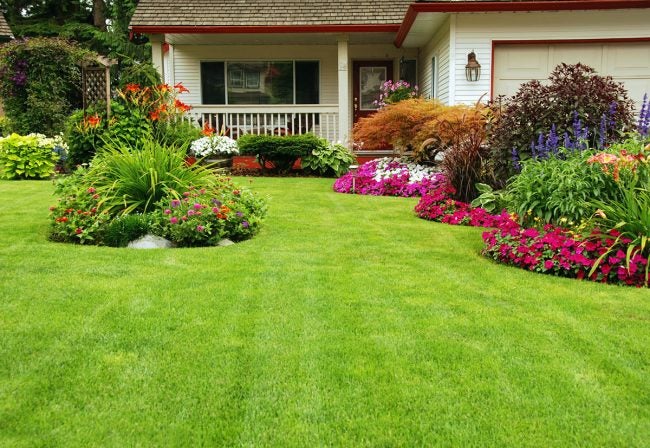How To: Overseed a Lawn For a Lush, Green Yard
Lawn and Garden
Overseeding improves the condition of your lawn by choking out weeds and clover and filling in bare spots.
By Stacey L Nash and Bob Vila https://www.bobvila.com/

A full, green lawn creates curb appeal and makes you feel like sipping an iced tea on the back patio. But if bare spots peek through and weeds overpower the grass, the lawn might be more of an eyesore than a point of pride. Overseeding chokes weeds and fills out the grass until it’s thick and lush. If you’re not sure how to overseed a lawn, all it takes is the right tools, smart timing, and a little knowledge about your local climate.
At its most basic, overseeding adds more grass to a lawn without turning the topsoil. For many homeowners, overseeding is part of general lawn maintenance. Some lawns might need overseeding once a year if drought or disease threaten the grass, and other lawns might need it every few years only to brighten the grass and keep it full. A few basic tools like a lawn mower, seed spreader, fertilizer spreader, and rake make up the basics needed for overseeding. With the right grass seed and timing, overseeding will restore the lawn and make it hard to resist spending the day lounging in the yard.
TOOLS & MATERIALS
We are a participant in the Amazon Services LLC Associates Program, an affiliate advertising program designed to provide a means for us to earn fees by linking to Amazon.com and affiliated sites.

Note: If the lawn has thatch (a compact layer of grass and soil), it might need aerating before overseeding. Otherwise, the grass seed used in overseeding won’t reach the soil to germinate and take root. Aerating creates holes in the grass and soil through which water, oxygen, and vital nutrients can reach the new grass seed and the roots of the existing grass.
Step 1
Mow and rake the lawn. The goal of overseeding a lawn is to get the grass seed in contact with the soil. To do that, the first step is to mow the lawn. Mow it shorter than usual so the grass seed will have a better chance of reaching the soil. Make sure to bag the clippings so they don’t come between the seeds and soil.

Step 2
Amend the soil. Soil amendments are different from fertilizers in that amendments have specific nutrients and chemical compositions for specific soil types. For example, lime, wood ash, and poultry manure raise the pH level of acidic soil to make it more suitable for certain plants and grasses. Sulfur amendments, on the other hand, add acidity to alkaline soil. Additions of peat moss for clay soil and compost for sandy soil also can improve the nutrients in and condition of the lawn.
If a lawn has not been growing and greening as it should, doing a soil test can determine the soil type and pH. The test results will identify what, if any, types of amendments the soil needs for grass to develop. Keep in mind that if the soil has a neutral pH and is fertile, it likely needs no amendments.

Step 3
Add the seeds. Load the grass seed into a seed spreader and spread about 16 seeds per square inch of soil. The right seed density will depend on the thickness of the existing lawn, so some lawns might need less. You also can spread grass seed by hand if you don’t have a spreader.
Choose a grass seed designed for your climate or region and that complements the existing grass. Lawns with cool-season grasses thrive in variable temperatures like those found in the Northeast and Pacific Northwest. Warm-season grasses grow best in a climate like that of the southern United States. Consulting the USDA Plant Hardiness Zone Map can help determine the average local climate to choose the appropriate grass type. Look for grass seed that’s rated by the National Turf Evaluation Program because these varieties have been tested and found resistant to disease, drought, and common pests.
Step 4
Apply fertilizer. Select the best fertilizer, and load it into a fertilizer spreader. Then, scatter around the perimeter of the lawn first to make sure fertilizer reaches the edges. Next, follow a pattern similar to a mowing pattern by moving in straight rows until the entire lawn is fertilized.
There are different types of fertilizer spreaders, including a broadcast spreader, handheld spreader, snap spreader, drop spreader, and liquid sprayer. Fertilizing small yards often requires a small handheld spreader only, while larger yards will take less time and effort with a broadcast spreader. The yard size and fertilizer type will determine which type of spreader is best. For example, liquid fertilizer requires a liquid fertilizer spreader like one of these quality backpack sprayers, and mid-sized yards are more easily fertilized with a snap or drop spreader.

Step 5
Water the lawn. After fertilizing, water the lawn for a short time each day. Water in the morning to maximize the water intake. More evaporation occurs during the afternoon and evening, which means it will take more water to get the same benefits. You don’t want to overwater, since this can wash the seed away, prevent germination, or encourage thatch development and the growth of fungus and weeds. If there are puddles or the ground feels spongy, cut back on the watering time
